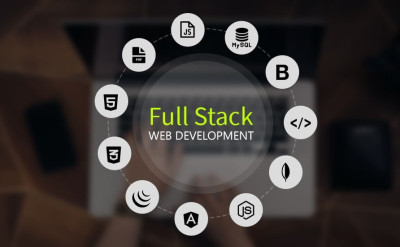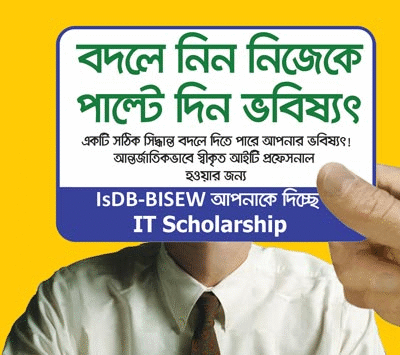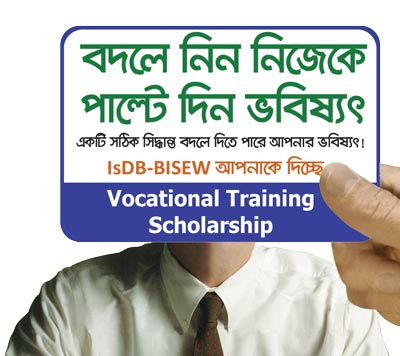Bi-monthly news update from IsDB-BISEW IT Scholarship Programme (July 2022)
Aug 25, 2022 / IT Scholarship Programme
Empower

Welcome to the July 2022 issue of Empower, the periodic newsletter of the IsDB-BISEW IT Scholarship Programme. This edition includes the following topics of note:
- Critical Skills Required for Becoming a Full Stack Developer
- Switching Careers – The IT Scholarship Programme Experience
Critical Skills Required for Becoming a Full Stack Developer
Full-stack developers are one of the most sought-after professionals in the field of software development. The reason is, that they have sound knowledge in both the frontend and the backend development of software applications and have to be aware of all the tools, and technologies that are being used to create different applications or websites. Besides this, full-stack developers are often responsible for user interface, user experience, and design patterns for a rich customer experience. This is one of the major reasons why they’re most popular and in-demand with an average salary bracket of BDT 6 Lac Per Annum – BDT 12 LPA and above for developers with mid-level seniority.
The urge for full-stack developers was so high during the pandemic that demands couldn’t be fulfilled by most countries (that includes the USA) and a recent study suggested that there will be a 20% jump in full-stack developers in the upcoming years. But is easy to get into full-stack development? The answer is no, and as a beginner, you might face certain challenges while trying to get into full-stack development. So, today we’re going to discuss all full-stack development and the skills that are required to become one.
Who’s a Full Stack Developer?
Let’s break the development into two parts – Front-end and Back-end development. Why so? Because any application or web development has these two major units to work on any projects.
The front-end developer works on the wireframe, interfaces, and visual parts of any project. (usually, they’re responsible for “what and how the user views the front screen while interacting with the app or web) and that’s why they’re known as front-end developers. On the other hand, the back-end developers are responsible for building logic, and architecture on how the app or web will work (and that also includes how and where the data will be stored and how it will flow), and since they work behind the curtains to create the base that’s why they’re known as back-end developers.
Let’s jump to our agenda and let’s discuss some of the most in-demand skills that are required to become a successful full-stack developer.
Skills Required to Become a Full-Stack developer
Below are some of the best and most desired skills to become a successful full-stack developer.
On the Front-End:
1. HTML & CSS
Abbreviated as Hypertext Markup Language, HTML is one of the most common terms and most people might be aware of it. It is used to prepare the structure of any website that we’re using today. However, it is mandatory for a full-stack developer to know the technical skills of using HTML whereas CSS or Cascading Style Sheets are generally used to style the HTML documents. In short, they’re responsible for making a rich experience and interface of any website. It also describes how and where the elements of an HTML should be displayed (including colour, placement, font, etc.) and to make the appearance of any webpage visually appealing.
2. JavaScript
JavaScript is a lightweight, interpreted programming language that can be used for front-end and back-end development. It brings life to the web pages thus making them interactive and dynamic. It can be embedded with HTML to create a web page. You can build modern web applications using JavaScript. It is the most used programming language in the world as a client-side programming language. Almost 97.0% of all websites use JavaScript.
3. Frameworks
A web framework (WF) or web application framework (WAF) is a software framework that is designed to support the development of web applications including web services, web resources, and web APIs. Web frameworks provide a standard way to build and deploy web applications on the World Wide Web. They aim to automate the overhead associated with common activities performed in web development. For example, many web frameworks provide libraries for database access, templating frameworks, and session management, and they often promote code reuse. Although they often target development of dynamic web sites, they are also applicable to static websites. Some of the most popular frameworks are as follows:
- React
- Angular
- Vue.js
At the Back-End:
4. Basic Understanding of Operating Systems
One of the most important factors while developing any software is to choose the platform on which it will run. That is why having knowledge of operating systems is vital for building any software. The most popular operating systems are listed below:
Types of Operating Systems:
- Windows
- Linux
- macOS
Things to Learn in Operating Systems:
There are a few important elements that you need to know while working on an operating system, the list entails the following units:
- Memory Management
- Process Management
- Inter-Process Communication
- Threads & Concurrency
- I/O Management & Scheduling
- File System
- Virtualization
5. Programming Languages to Learn
Besides getting a full command of front-end programming languages, it is still mandatory for you to have knowledge of back-end programming languages. All you need to do is to make sure that you learning one or more of the languages shown below. The languages along with their frameworks are:
- Java and Spring Boot
- C# and associated .Net stack
- PHP and Laravel
- Python and Django
6. Proficiency in VCS (Version Control System)
Version control, also known as source control, is the practice of tracking and managing changes to software code. Version control systems are software tools that help software teams manage changes to source code over time. As development environments have accelerated, version control systems help software teams work faster and smarter.
Being proficient in VCS requires both the understanding of project management and keeping track of the entire history. VCS also defines how a company’s workflows are bound with it. That’s why having knowledge of at least one of the most popular version control systems will solve most of the problems of tracking changes. It’s also a platform for developers to interact and discuss their ideas and issues. Some of the best VCS are:
- GIT
- GitHub
- GitLab
- Apache Subversion
7. Knowledge of Database
Nearly everything we interact with on a daily basis is built over a database. From the online game you play, to the virtual coin you earn in the game, to the real money you spend online, to the inventory you purchase, to the contact list on your cell phone it is all information stored in a database. This almost universal requirement would require you (as a full stack developer) to possess the skillset to write queries so that data can be called, saved and modified when required and for that having solid knowledge of database is a basic requirement. Being a full-stack developer comes with a lot of responsibilities and thus possessing the skills for designing and manipulating database is a must.
However, if you’re wondering what kind of database you need to work on, so basically there are two major types of databases that are mostly being used in the industry. These are:
Relational Database:
- MySQL
- MS-SQL Server
- PostgreSQL
- Oracle Database
Non-Relational Database:
- MongoDB
- Apache Cassandra
- NoSQL
8. Gain Insights into “API”
API stands for Application Programming Interface. In the context of APIs, the word Application refers to any software with a distinct function. Interface can be thought of as a contract of service between two applications. This contract defines how the two communicate with each other using requests and responses. Their API documentation contains information on how developers are to structure those requests and responses.
APIs are mechanisms that enable two software components to communicate with each other using a set of definitions and protocols. For example, the weather bureau’s software system contains daily weather data. The weather app on your phone “talks” to this system via APIs and shows you daily weather updates on your phone.
Nowadays, when we’re talking about APIs, we’re typically referring to web service APIs, which expose an application’s data and functionality over the internet. If you look closely, you’ll see that web APIs power our everyday lives:
- When you log into a website using your Facebook profile
- When you switch on Netflix and see dozens of new movies flood the screen
- When you look for flights on Google
… and the list goes on and on
The most widely used web API standards for backend development are:
- XML-RPC
- JSON-RPC
- REST
9. Testing
Software testing is the process of evaluating and verifying that a software product or application does what it is supposed to do. The benefits of testing include preventing bugs, reducing development costs and improving performance. Even a simple application can be subject to a large number and variety of tests. A test management plan helps to prioritize which types of testing provide the most value – given available time and resources. Testing effectiveness is optimized by running the fewest number of tests to find the largest number of defects.
There are three categories of testing such as structural, functional, and non-functional testing. Some of the best testing tools are:
- Selenium
- Data Generator
- WebLOAD
- Acunetix
10. Use of Monitoring Tools
While working on any project, especially when is app is ready to push for LIVE, there are certain times when an app gets crashed. That’s where the requirement of monitoring rises, and full-stack developers are responsible for monitoring application logs, and server status and should be capable enough to handle crashes and to solve any complexity especially when the app is live.
How Hard is it to Become One?
If you wish to start your career in full-stack development then you need to have consistency, passion, and patience. The best way to prepare yourself would be to enrol yourself in a full-stack development course where you can get a thorough set of knowledge and skills needed for web development and learn how to develop industry-ready apps. The IsDB-BISEW IT Scholarship Programme offers four such courses. These are:
- Web Application Development with PHP and Frameworks (WDPF):
Based on the highly popular PHP language and the Laravel framework, the WDPF course also covers numerous other web technologies and focuses on Open-Source platforms;
- Enterprise Systems Analysis & Design - C#.NET (ESAD-C#.NET)
The ESAD-C#.NET course is based on Microsoft’s .NET web stack and frameworks that provides a solid grounding on web technologies required to develop enterprise-level web applications. It also covers Open-Source web technologies;
- Enterprise Systems Analysis & Design – JEE (ESAD-JEE)
The ESAD-JEE course centres around Java and its associated framework and tools required for robust enterprise-level technologies required for full-stack web development;
- Database Design & Development (DDD)
Based on the Oracle database server and its front-end tools, the course DDD also includes tools and technologies required for developing full-stack web development applications as well as Desktop based applications.
Switching Careers – The IT Scholarship Programme Experience
Md. Babul Akhtar

"Career choice can shape a person's life" – says Md. Babul Akhtar, an IT professional working in Grameenphone. "I joined Grameenphone in 2016. I am now a Senior Executive working in Business Intelligence. My academic background, however, is Chemistry (Honours) with a professional diploma in computing from the IsDB-BISEW IT Scholarship Programme."
Babul Akhtar studied Chemistry at Govt. Edward College in Pabna. Classes were irregular and the lab facilities were totally inadequate during his stay in the college. Studying chemistry became a laborious task for Babul. Despite the circumstances, he persevered and with the help of private tuition Babul passed his finals and graduated in 2011. Along with his fellow students, Babul felt that compared to graduates of public universities, graduates like him coming from the National University were discriminated against in the job market.
"After graduation, the career options open for Chemistry graduates were either that of Sales Representatives for pharmaceutical companies or working in a lab for which I was not prepared at all." At this stage, Babul felt that he needed to rethink his career pathway. A friend, a few years his senior informed him that he was going to apply for the IsDB-BISEW IT Scholarship. A career as an IT professional appealed to Babul. He also decided to apply for the scholarship. Babul and his friend were overjoyed when both of them were selected for the scholarship in Round-15 of the programme.
The systematic training methodology used in the IT Scholarship Programme impressed Babul. It encouraged him to work hard in acquiring new skills and he completed the one-year long course Database Design & Development without any difficulty in 2012. His first job was in Berger Paints as a project member of their software development team. He served there for three months as this was a project-based job. He had no problem finding a new job with better pay and got employed at Leads Corporation as a Software Engineer. Eventually, Babul was recruited by Grameenphone where he is now serving in a senior position.
"The IT Scholarship Programme has given me a rewarding career. I fortunately, took the correct decision of enrolling in the programme even though the career path I chose had no relationship with my college education. I hope the IT Scholarship Programme continues to provide opportunities to students who are in search of a satisfying professional career."
Copyright @ 2022 IsDB-BISEW, All rights reserved.





